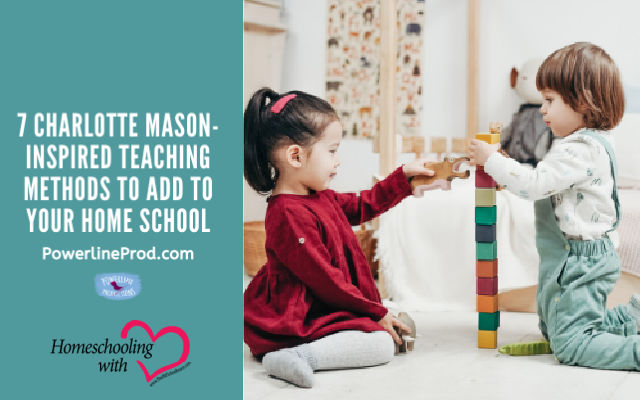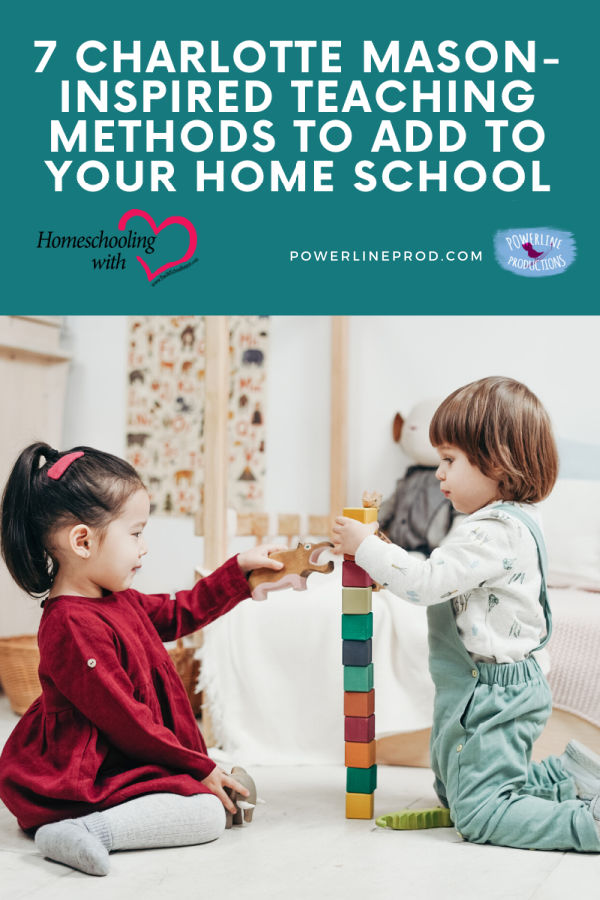7 Charlotte Mason-Inspired Teaching Methods to Add to Your Home School


Charlotte Mason, a Christian educator who lived over a century ago, has inspired me to cultivate wonder, use living books, cultivate good habits, enjoy nature, use narration, and explore art and music in my homeschool.
Our entire family has benefited from these practical ways to make learning fun and help children remember what they learn for years to come.
Living Books
Living books inspire, enchant, delight, and engage our children. Charlotte Mason loved living books!
A well-written, beautifully illustrated picture book becomes a dear friend to young children, and they want to hear it read aloud again and again and again. You can read aloud well-written, beautifully illustrated books to babies from birth.
We do most of our learning through living books. Genevieve Foster, G.A. Henty, Landmark books, We Were There books, and Childhood of Famous Americans biographies taught us world and American history. If we used a textbook, we always added tons of read-aloud time with living books. Historical fiction brought different times and places alive, too.
For geography, we loved Hans Brinker, Heidi, Around the World in 80 Days, and the Reel Kids Adventure books.
We discovered all kinds of living books for science studies from Answers in Genesis, Master Books, and the local library. Sometimes, we found books with beautiful pictures and just looked at the pictures.
I discovered there are many lovely picture books written for older children, teens, and adults. Don’t forget about coffee table books! With their beautiful photographs, they add so much fun to learning. Look for them in the library.
I tried to give my children a good balance between listening to books read by others, reading on their own, and reading aloud to others. All three build different skills.
Reading excellent books takes children on adventures to different places and time periods. It also builds vocabulary, helps sharpen grammar skills, helps with spelling, and gives children a method of obtaining knowledge in all different spheres. It is the best way to learn!
For more on living books, read 5 Ways to Homeschool with Living Books.
Habits
Charlotte Mason talked often about habits. She believed in establishing good habits early in life, and she felt a wise mother would take whatever it took to establish those good habits in her children.
I remember starting early to build habits with our children. It started each morning with doing their 5 things: making their bed, brushing their teeth and hair, getting dressed, tidying their room, and reading their storybook Bibles before coming down to breakfast.
When they got downstairs, we would ask “Did you do your 5 things?”
In the beginning, it would require a lot of time and effort on our part to train each child. We would teach them by making their bed with them, helping them to get dressed, and praying with them before heading out of their room to breakfast.
The hard work paid off! We were grateful years later we had invested the time.
We worked on other habits such praying, manners, chores, communication skills, study habits, and putting away what they got out.
Good habits truly make life less stressful though they take a lot of time to build!
Cultivating Wonder
Little ones are born with a curiosity and wonder. They want to learn about the world around them. Education should cultivate, not stifle that wonder according to Charlotte Mason. I agree!
Telling toddlers and preschoolers who ask a million questions, “That’s a great question!” or “I love that you are curious and excited to learn!” can cultivate a love of learning.
Keeping learning time cheerful and relaxed goes a long way in making education something positive, rather than a bore. Being excited as a parent teacher can make our children enthusiastic about learning.
I love to learn! So, over the years I have been upbeat about learning, and when I’m not really interested in a topic, I actually pray and ask God to change my heart. I know that wonder and curiosity are “caught” from those around my children, especially me.
I like to introduce my children to interesting people who have done interesting things.
“Did you know Mr. Sam is a fireman? Sam, what’s it like to drive those big tucks and put out a fire?”
“Maria, can you tell my children what it was like to live in Cuba in the 1960s?”
“Daddy, can you tell the kids what it was like to grow up on a farm?”
“Carl, can the kids watch you weld something?”
Here are some of the items I have purchased for my homeschool that have cultivated curiosity:
- A beautiful easy-to-read globe
- A dictionary with pictures for little ones
- A tote of art supplies that they can take out and use whenever they want
- Bookcase after bookcase full of inviting books
- Well-written, beautifully illustrated picture books for all ages
- Fine art prints
- Maps
- Dolls, stamps, and coins from other countries
- Blank journals
- Excellent music audios
- Meaningful photographs
- Antiques
- Board and card games of all sorts
- Old cookbooks
Narration
Charlotte Mason also recommended narration as a teaching method. Narration is used to evaluate what the students knows about a subject you are studying together. It goes far beyond memorizing facts for a test. When students can express what they remember clearly and talk about the subject, the learning has gone deep! In fact, narrating actually is a learning process as students formulate what they will share.
Narration can be conversational or in writing.
As a homeschooling mom, I learned early on that what my kids could talk about clearly was what they truly had learned. Conversations have been a big part of our homeschooling. Written narration can be answering simple questions or writing paragraphs and papers.
I love this way of evaluation! It is much more accurate than testing.
For more about narration, read How to Use Narration in Your Home School and 7 Ways Narration Can Help You Homeschool.
Copying & Dictation
Copying and dictation were Charlotte Mason’s method of introducing grammar and spelling.
My children copied numerous Scripture verses to learn handwriting. In many of our unit studies, they copied passages from living books we were reading.
As the children got older, I would sometimes dictate a passage to them. Afterward, I would have them compare it to the actual book I was reading from and let them make corrections. This was such a great way to understand the flow of sentences and to see their own grammar/spelling mistakes.
Nature Study
Charlotte Mason believed that there were all kinds of benefits from spending large amounts of time outdoors. Her students kept nature journals.
From climbing trees to bird watching, nature is full of homeschool lessons!
We loved to explore nature at the beach! We strolled along the water’s edge, noticing the little sea creatures and birds. We collected shells and built sand castles. This naturally led into oceanography studies.
Listen to 1,001 Homeschool Days at the Beach for ideas of nature study and more at the beach!
Enjoying Art & Music
With a desire to expose children to excellence and beauty, Charlotte Mason liked to focus in on an artist or composer. Her students would enjoy the art or music, read about him, and try to reproduce his style in their playing, painting, or sculpting.
We have listened to all kinds of music and looked at all kinds of art over the years. It’s been fun to read a short biography or historical fiction novel about different composers and artists.
We’ve tried splatter painting (abstract-expressionist), pointillism with colored pencils, and impressionism with watercolors. We’ve also tried duplicating ancient artwork and copying famous artists’ works.
Here’s more on our experience with splatter painting with Try Splatter Painting to Study Abstract-Expressionist 20th Century Art the Fun Way.
Have you considered adding some of these teach methods to your homeschool? They can create an atmosphere that makes learning fun and teaching easier! I love so much about Charlotte Mason’s style of teaching. Adding these Charlotte Mason-inspired things to my homeschooling has enriched our family. I’d love to hear about your experiences with Charlotte Mason-style homeschooling in the comments below.
Until next time, Happy Homeschooling,
Warmly,
Meredith Curtis
Meredith Curtis, homeschooling mom, writer, speaker, and publisher, loves to encourage families in their homeschooling adventure. She is the author of Seven R’s of Homeschooling, Travel God’s World Geography, Travel God’s World Cookbook, and HIS Story of the 20th Century. You can check out her books, curricula, unit studies, and Bible studies at PowerlineProd.com. Free Reading Lists for all ages are available at JSHomeschooling.com. Read her blogs at PowerlineProd.com and listen to her at Finish Well Podcast.














































